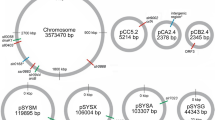Abstract
Gabaculine (2,3-dihydro 3-amino benzoic acid) is a potent inhibitor of tetrapyrrole biosynthesis in organisms that use the C5 pathway for the synthesis of δ-aminolaevulinic acid. Glutamate semialdehyde aminotransferase (GSA-AT), the enzyme catalysing the formation of this key precursor of tetrapyrroles, is normally inhibited by concentrations of gabaculine in the order of 5 μM. However, in Synechococcus 6301 strain GR6, a cyanobacterium that is resistant to 100 μM gabaculine, this enzyme has undergone two changes in structure: a deletion of three amino acids from positions 5 to 7 and the substitution of isoleucine for methionine at position 248. To establish the effect in vivo of these specific changes in the gene for GSA-AT (hemL), a suicide vector (pHS7) containing an antibiotic cassette was constructed to achieve the replacement, by homologous recombination, of the wild-type hemL gene in the chromosome by a modified form of the gene. Recombinant strains of Synechococcus 7942 obtained using pHS7-hemL GR6 were indistinguishable from Synechococcus 6301 GR6 in terms of the resistance of growth and of chlorophyll accumulation to high concentrations of gabaculine, while a wild-type recombinant produced using pHS7-hemL WT had retained its sensitivity. Southern hybridisation using gene probes for hemL, amp r and cm r confirmed that chromosomal integration of the plasmids had occurred in both WT and GR6 recombinants. Growth and chlorophyll accumulation in equivalent strains with the hemL gene containing either the deletion or the transition characteristic of Synechococcus 6301 GR6 were inhibited by 10 μM gabaculine. Consequently, resistance in vivo to high concentrations of this compound is dependent on both the changes in gene/enzyme structure. This investigation has established the effectiveness of the suicide vector pHS7 for studying the effect in vivo of specific changes in the hemL gene. It has also demonstrated that replacement of the wild-type gene by that from Synechococcus 6301 GR6 is sufficient to confer resistance in vivo to high concentrations of gabaculine.
Similar content being viewed by others
Author information
Authors and Affiliations
Additional information
Received: 7 October 1996 / Accepted: 15 January 1997
Rights and permissions
About this article
Cite this article
Allison, G., Gough, K., Rogers, L. et al. A suicide vector for allelic recombination involving the gene for glutamate 1-semialdehyde aminotransferase in the cyanobacterium Synechococcus PCC 7942. Mol Gen Genet 255, 392–399 (1997). https://doi.org/10.1007/s004380050511
Issue Date:
DOI: https://doi.org/10.1007/s004380050511




